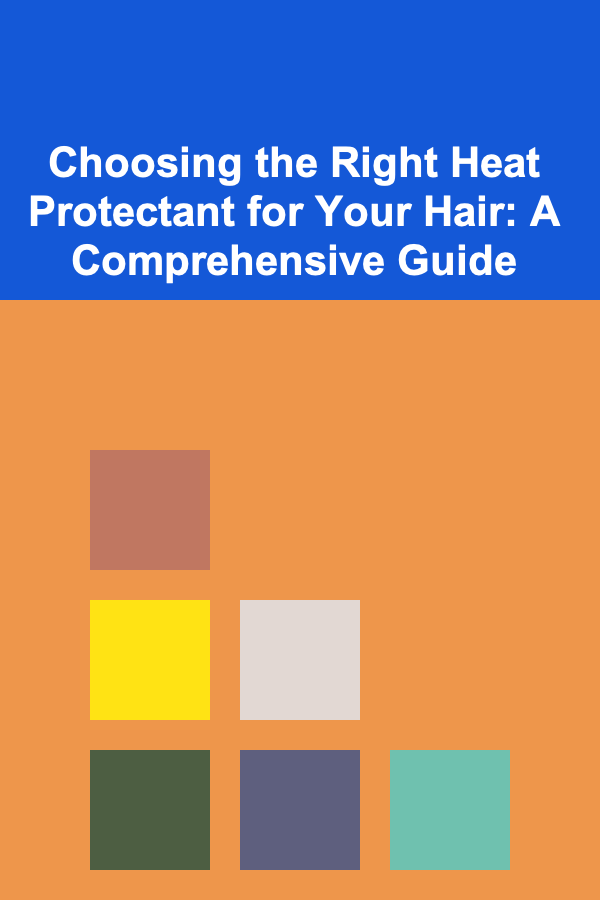
Choosing the Right Heat Protectant for Your Hair: A Comprehensive Guide
ebook include PDF & Audio bundle (Micro Guide)
$12.99$11.99
Limited Time Offer! Order within the next:

Heat styling tools, such as blow dryers, flat irons, curling irons, and hot rollers, have become indispensable for achieving a polished and stylish look. However, the high temperatures they generate can wreak havoc on hair health, leading to dryness, breakage, split ends, and color fading. Therefore, incorporating a heat protectant into your hair care routine is crucial for minimizing damage and maintaining the overall health and vitality of your locks. But with a plethora of products available on the market, selecting the right heat protectant can feel overwhelming. This comprehensive guide delves into the science behind heat damage, explores the different types of heat protectants, and provides a framework for choosing the best option for your specific hair type and styling habits.
Understanding Heat Damage: The Science Behind the Scorch
To effectively protect your hair from heat, it's essential to understand how heat actually damages the hair structure. Hair is primarily composed of keratin, a protein that provides strength and elasticity. Heat weakens and denatures keratin through several mechanisms:
- Moisture Loss: Heat rapidly evaporates moisture from the hair shaft. Water molecules play a vital role in maintaining the hair's pliability and preventing breakage. When water is lost, the hair becomes brittle and prone to snapping. The boiling point of water is 212°F (100°C). Most styling tools operate at temperatures exceeding this, causing immediate and significant water loss.
- Cuticle Damage: The hair cuticle, the outermost layer, consists of overlapping scales that protect the inner cortex. Excessive heat can lift and damage these scales, making the hair appear rough, frizzy, and dull. A compromised cuticle also makes the hair more susceptible to environmental damage and chemical processing.
- Protein Denaturation: High temperatures can alter the structure of the keratin proteins within the hair cortex. This denaturation process weakens the hair's overall structure, making it less resistant to breakage and less able to hold its shape. The hair loses its elasticity and strength.
- Lipid Depletion: Hair also contains natural oils (lipids) that contribute to its shine and smoothness. Heat can strip away these lipids, leaving the hair feeling dry and rough. These lipids act as a natural barrier, protecting the inner layers of the hair from external aggressors.
- Color Fading: For color-treated hair, heat can accelerate color fading by opening the cuticle and allowing color molecules to escape. This leads to a dull and lackluster appearance.
The severity of heat damage depends on several factors, including the temperature of the styling tool, the duration of heat exposure, the frequency of styling, and the overall health of the hair. Repeated exposure to high heat, without adequate protection, can lead to irreversible damage.
How Heat Protectants Work: A Shield Against the Scorch
Heat protectants act as a barrier between the hair and the heat source, mitigating damage through several mechanisms:
- Thermal Insulation: Many heat protectants contain polymers or silicones that create a thin, protective layer on the hair surface. This layer acts as an insulator, slowing down the rate at which heat penetrates the hair shaft. This allows the hair to heat up more gradually, reducing the risk of rapid moisture loss and protein denaturation.
- Moisture Retention: Some heat protectants contain humectants, ingredients that attract and retain moisture. By drawing moisture from the environment and holding it within the hair shaft, these products help to prevent dehydration during heat styling. Examples of common humectants include glycerin and hyaluronic acid.
- Lubrication: Many heat protectants contain silicones or oils that provide lubrication, reducing friction between the styling tool and the hair. This helps to prevent breakage and snagging, particularly when using flat irons or curling irons. The lubrication also contributes to a smoother, shinier finish.
- Heat Distribution: Some formulations help to distribute heat more evenly across the hair shaft, preventing localized overheating and minimizing the risk of damage in specific areas. This is particularly important when using flat irons, which can concentrate heat in small sections of hair.
Types of Heat Protectants: Finding the Right Formula for You
Heat protectants come in various formulations, each with its own set of advantages and disadvantages. Understanding the different types is crucial for selecting the most appropriate product for your hair type and styling needs.
1. Sprays
Spray heat protectants are lightweight and easy to apply, making them a popular choice for many. They typically contain alcohol, which helps them to dry quickly and evenly. However, the alcohol content can also be drying for some hair types. Sprays are generally best suited for fine to normal hair that is not overly dry or damaged. They provide a light layer of protection without weighing the hair down.
Pros:
- Lightweight and non-greasy
- Easy to apply
- Quick-drying
- Good for fine to normal hair
Cons:
- May contain alcohol, which can be drying
- May not provide enough protection for thick or coarse hair
Key Ingredients to Look For: Look for sprays that contain silicones like dimethicone or cyclomethicone for heat protection, and humectants like glycerin for moisture retention. Also, consider sprays with added UV protectants to shield hair from sun damage.
2. Serums
Serum heat protectants are typically oil-based and provide a richer, more moisturizing formula than sprays. They are ideal for dry, damaged, or thick hair that needs extra hydration and protection. However, serums can be too heavy for fine or oily hair, potentially weighing it down and making it look greasy.
Pros:
- Provide intense moisture and protection
- Good for dry, damaged, or thick hair
- Can add shine and smoothness
Cons:
- Can be heavy and greasy for fine or oily hair
- May need to be applied sparingly
Key Ingredients to Look For: Look for serums containing argan oil, coconut oil, or other nourishing oils. Silicones can also provide heat protection and add shine. Avoid serums with excessive amounts of heavy oils if you have fine hair.
3. Creams
Cream heat protectants offer a balance between the lightweight nature of sprays and the moisturizing properties of serums. They are a versatile option that can work well for a variety of hair types, particularly normal to slightly dry hair. Creams provide a moderate level of heat protection and can help to detangle and smooth the hair.
Pros:
- Versatile and suitable for many hair types
- Provide moderate moisture and protection
- Can help to detangle and smooth the hair
Cons:
- May be too heavy for very fine hair
- May not provide enough protection for very thick or damaged hair
Key Ingredients to Look For: Look for creams that contain silicones, humectants, and emollients (ingredients that soften and smooth the hair). Panthenol (vitamin B5) is also a beneficial ingredient for strengthening and hydrating the hair.
4. Oils
While some pure oils like coconut oil and argan oil are sometimes touted as natural heat protectants, their effectiveness is debated. While they can provide some lubrication and moisture, they typically don't offer the same level of heat protection as formulated heat protectants with silicones or specialized polymers. Using pure oils alone can sometimes lead to the oil burning or smoking when exposed to high heat, potentially damaging the hair. However, formulated oil-based heat protectants, which are specifically designed for heat styling, can be a good option for dry, coarse, or curly hair.
Pros:
- Can provide moisture and lubrication
- Good for dry, coarse, or curly hair (formulated oils)
Cons:
- Pure oils may not provide sufficient heat protection
- Pure oils can potentially burn or smoke when exposed to high heat
- Formulated oils can be heavy for fine hair
Key Ingredients to Look For: If using a formulated oil-based heat protectant, look for a blend of oils and silicones. Avoid using pure oils alone for heat styling, unless they are specifically formulated for that purpose.
5. Mousse
Heat protectant mousses are designed to provide both heat protection and hold for styling. They are particularly suitable for creating volume and definition, while also shielding the hair from heat damage. They can be a good option for fine to medium hair that needs both protection and styling support.
Pros:
- Provides heat protection and styling hold
- Good for creating volume and definition
- Can be used on damp or dry hair
Cons:
- Can be drying for some hair types
- May leave a sticky residue if used excessively
Key Ingredients to Look For: Look for mousses that contain silicones, polymers for hold, and moisturizing ingredients. Avoid mousses with high alcohol content, which can be drying.
Choosing the Right Heat Protectant: A Personalized Approach
Selecting the best heat protectant requires considering your individual hair type, styling habits, and desired results. Here's a breakdown to guide you through the process:
1. Identify Your Hair Type:
- Fine Hair: Fine hair is delicate and easily weighed down. Opt for lightweight sprays or very light creams. Avoid heavy serums or oils.
- Medium Hair: Medium hair is generally versatile and can tolerate a wider range of products. Creams, sprays, or light serums can all be suitable options.
- Thick Hair: Thick hair requires more moisture and protection. Serums, creams, or formulated oil-based heat protectants are good choices.
- Dry Hair: Dry hair needs extra hydration. Choose moisturizing serums, creams, or oil-based heat protectants.
- Oily Hair: Oily hair is prone to greasiness. Opt for lightweight sprays or mousses and avoid heavy serums or oils.
- Damaged Hair: Damaged hair requires intensive repair and protection. Look for heat protectants that contain keratin, protein, or other repairing ingredients.
- Color-Treated Hair: Color-treated hair is more susceptible to damage. Choose heat protectants specifically formulated for color-treated hair to protect against fading. These often contain UV filters.
- Curly Hair: Curly hair tends to be dry and prone to frizz. Choose moisturizing serums, creams, or oil-based heat protectants that can help to define curls and reduce frizz.
- Straight Hair: Straight hair can benefit from lightweight sprays or creams that add shine and smoothness without weighing it down.
2. Consider Your Styling Habits:
- Frequency of Heat Styling: If you heat style your hair frequently (e.g., daily), you'll need a more robust heat protectant. Choose a serum or cream that provides maximum protection.
- Temperature of Styling Tools: If you use high temperatures on your styling tools, you'll need a heat protectant that can withstand the heat. Look for products that are specifically designed for high-heat styling.
- Type of Styling Tool: Different styling tools require different levels of protection. Flat irons and curling irons, which apply direct heat, require more protection than blow dryers.
- Desired Style: If you're aiming for a voluminous style, choose a heat protectant mousse. If you're aiming for a sleek and smooth style, choose a serum or cream.
3. Read Labels and Research Ingredients:
Pay close attention to the ingredient list and look for key ingredients that provide heat protection, moisture, and repair. Avoid products that contain harsh chemicals or excessive amounts of alcohol.
Key Ingredients to Look For:
- Silicones: Dimethicone, cyclomethicone, and amodimethicone are common silicones that provide heat protection and add shine.
- Polymers: PVP/VA copolymer and other polymers create a protective barrier against heat.
- Humectants: Glycerin, hyaluronic acid, and panthenol attract and retain moisture.
- Oils: Argan oil, coconut oil, and jojoba oil provide moisture and lubrication (use formulated oils, not pure oils, for best results).
- Amino Acids: Help to repair and strengthen damaged hair.
- UV Protectants: Protect hair from sun damage, especially important for color-treated hair.
Ingredients to Avoid (or be cautious about):
- High Alcohol Content: Can be drying, especially for already dry or damaged hair. Look for alcohol-free or low-alcohol formulations.
- Sulfates: Can strip the hair of its natural oils.
- Parabens: Some people prefer to avoid parabens due to potential health concerns.
4. Consider Your Budget:
Heat protectants are available at a wide range of price points. While more expensive products may contain higher-quality ingredients, you can still find effective heat protectants at affordable prices. Read reviews and compare ingredients to find a product that fits your budget and meets your needs.
5. Patch Test and Trial:
Before applying a new heat protectant to your entire head of hair, perform a patch test on a small, inconspicuous section to check for any allergic reactions or sensitivities. Once you've determined that the product is safe to use, apply it according to the instructions and style your hair as usual. Pay attention to how your hair feels and looks after styling to determine if the product is working well for you. Try different products until you find the one that best suits your hair type and styling habits.
Application Techniques: Maximizing Protection
The effectiveness of a heat protectant depends not only on the product itself but also on how it's applied. Follow these tips to ensure that you're getting the most out of your heat protectant:
- Apply to Clean, Detangled Hair: For best results, apply heat protectant to clean, detangled hair. This allows the product to distribute evenly and penetrate the hair shaft more effectively.
- Apply Evenly: Ensure that you apply the heat protectant evenly throughout your hair, from root to tip. Use a wide-tooth comb to distribute the product evenly, especially for thicker hair.
- Use the Right Amount: Don't use too much or too little product. Too little product won't provide enough protection, while too much product can weigh the hair down or make it feel greasy. Follow the instructions on the product label.
- Apply Before Every Heat Styling Session: Reapply heat protectant every time you heat style your hair, even if you've already applied it earlier in the day.
- Focus on the Ends: The ends of your hair are the most vulnerable to damage, so pay extra attention to applying heat protectant to this area.
- Apply to Damp or Dry Hair, Depending on the Product: Some heat protectants are designed to be applied to damp hair, while others are designed to be applied to dry hair. Follow the instructions on the product label.
Beyond Heat Protectant: A Holistic Approach to Hair Health
While heat protectant is an essential part of preventing heat damage, it's important to adopt a holistic approach to hair health that includes other strategies:
- Use Heat Styling Tools Sparingly: Limit your use of heat styling tools to reduce the overall exposure to heat.
- Lower the Temperature of Styling Tools: Use the lowest effective temperature setting on your styling tools. Modern tools often have adjustable temperature controls; experiment to find the lowest setting that still achieves your desired style.
- Deep Condition Regularly: Use a deep conditioner or hair mask once or twice a week to replenish moisture and repair damage.
- Trim Your Hair Regularly: Regular trims remove split ends and prevent them from traveling up the hair shaft, further damaging your hair.
- Eat a Healthy Diet: A balanced diet rich in vitamins, minerals, and protein is essential for healthy hair growth.
- Protect Your Hair from the Sun: UV rays can damage hair, so wear a hat or use a hair product with UV protection when spending time outdoors.
- Minimize Chemical Processing: Chemical treatments like perms, relaxers, and coloring can weaken the hair. If you use these treatments, take extra care to protect and nourish your hair.
Conclusion: Protecting Your Tresses for Long-Term Health
Choosing the right heat protectant is a crucial step in maintaining the health and beauty of your hair, especially if you regularly use heat styling tools. By understanding the science behind heat damage, exploring the different types of heat protectants, and considering your individual hair type and styling habits, you can select the product that will provide the best protection for your locks. Remember to apply the heat protectant correctly and to adopt a holistic approach to hair health that includes other strategies for minimizing damage and promoting healthy growth. With the right heat protectant and a consistent hair care routine, you can enjoy stylish and healthy hair for years to come.

How to Organize Your Kids' Toys for Stress-Free Playtime
Read More
How to Save Space with Folding Doors and Partitions
Read More
How to Use Minimalist Decor for a Cozy Holiday Vibe
Read More
How to Use SMS Automation for Upselling During Abandoned Cart Recovery in Dropshipping
Read More
How to Pair Wine with BBQ and Grilled Foods
Read More
10 Tips for Creating Realistic Cross-Stitch Portraits
Read MoreOther Products

How to Organize Your Kids' Toys for Stress-Free Playtime
Read More
How to Save Space with Folding Doors and Partitions
Read More
How to Use Minimalist Decor for a Cozy Holiday Vibe
Read More
How to Use SMS Automation for Upselling During Abandoned Cart Recovery in Dropshipping
Read More
How to Pair Wine with BBQ and Grilled Foods
Read More